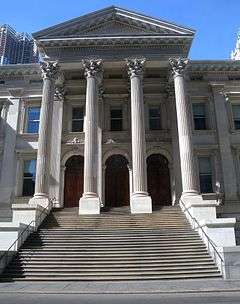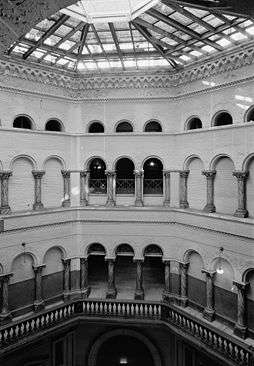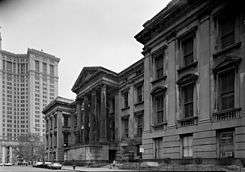Tweed Courthouse
The Old New York County Courthouse at 52 Chambers Street in Manhattan, New York City, more commonly known as the Tweed Courthouse, was built in Italianate style with Romanesque Revival interiors, using funds provided by the corrupt William M. "Boss" Tweed, whose Tammany Hall political machine controlled the city and state governments at the time.
The outer shell of the building was constructed from 1861–1872 by the architect John Kellum, with the political appointee Thomas Little.[4] Construction was interrupted when the kickbacks and corruption involved in the construction of the building were disclosed to the public.
The project was completed by architect Leopold Eidlitz who added the rear wing and interior renovations from 1877–1881, departing from Kellum's classicism with "an American version of organic architecture expressed through medieval forms".[5]
The building was designated a New York City landmark and added to the National Register of Historic Places, both in 1984, when it was called "one of the city's grandest and most important civic monuments".[5] It was named a National Historic Landmark in 1986.[3][6][7]
Modern restoration and historic preservation of the courthouse were completed in 2001, and the building is now home to the New York City Department of Education. The Tweed Courthouse is the second oldest city government building in Manhattan, after City Hall.[8]
Architecture
The building is composed of a central section with two projecting wings, with an addition in the center on the south facade. The entry portico on the main Chambers Street facade (illustration) rises three and a half stories from a low granite curb, supported by four Corinthian columns. Panels of granite and Tuckahoe and Sheffield marbles[9] are anchored to the outside of the brick structure, with rusticated stone at the basement level. This main wing was designed by Kellum in the style of the Renaissance palazzo, described as the "Anglo-Italianate" style to reveal the influence of British Victorian architecture that was the foundation of the popular American Victorian style.
The southern wing of the courthouse was constructed in the Romanesque Revival style by the German-born architect and theoretician Leopold Eidlitz, who added the wide rotunda enclosing the central courtyard, which Kellum had intended to be capped with a dome, which was never built. On the east and west sides of the rotunda are sets of cast iron stairs that run from the first to the third floors. The pillars on the interior were faux painted to resemble marble pillars, and the cast-iron handrails at the staircase were painted with a wood-grained finish.
History
The location had previously been occupied by the public commons and a poorhouse.[10] Tweed became one of the wealthiest New Yorkers of the day by using the construction of the building as a pretext to embezzle millions of dollars from the city government and the public. "Boss" Tweed stole an estimated 75 million dollars (at least) from New York City public funds. Tweed is considered one of the most corrupt politicians in United States history. Tweed assembled a ring of political allies who helped maintain his corrupt business all the while furthering his political agenda as well. A series of disruptions culminated in the trial of "Boss" Tweed in an unfinished courtroom of this building in 1873. In 1876, Eidlitz was commissioned to complete an expanded design, redesigning the neoclassical interiors of Kellum with rich polychrome effects in Romanesque Revival style. The Tweed courthouse was finally finished in 1881, more than 20 years after work began. The total cost of construction was estimated in 1914 at $11 million to $12 million,[5] but the amount of money pocketed by the Tammany Hall group is unknown. The expanded design provided thirty monumental courtrooms ranged round the central three-storey octagonal rotunda.
John Kellum began his career as a house carpenter, later forming the firm King & Kellum in 1846 as the junior partner of Gamaliel King, architect of Brooklyn Borough Hall, the project for which he required an on-site partner. The firm designed commercial buildings, including the landmarked Cary Building at 105-107 Chambers Street, one of the earliest cast-iron facades in New York City. Kellum started his own practice in 1860, and designed several buildings for Alexander T. Stewart, including his department store at Broadway and 10th Street, which burned down in 1956, and the master plan for Garden City, Long Island. Thomas Little, a political appointee of the New York City Board of Supervisors, was given ex officio credit along with Kellum.
Leopold Eidlitz is best known for his work on the New York State Capitol. Eidlitz was hired in 1876 to finish the courthouse after the initial architect, John Kellum, died before completion. He added the building's south wing and domed rotunda. The Romanesque style and his extensive use of brick and stone transformed the appearance of the courthouse, in contrast to Kellum's intricate cast-iron design.
In 1927, the County Court moved from the Tweed Courthouse to the new New York County Courthouse a few blocks north on Centre Street.[11]
Preservation
In the spring of 1999, John G. Waite Associates began the $85 million complete restoration of the building. The firm carefully removed as much as 18 layers of paint to reveal the original brick walls and cast iron in order to recreate the original paint colors. The skylights and structure of the roof over the rotunda were replaced, marble and glass tiled floors were restored and additional detail was carved into the capitals of the exterior columns at the portico, where the sheared-away entrance steps were replaced. The original ventilation shafts in the building's walls were used for modern heating, ventilation, and air conditioning (HVAC) systems to maintain the appearance of the interior spaces. In addition, the front steps, which had been removed to accommodate a widening of Chambers Street, were restored.[12]
The Guide to New York City Landmarks characterizes the building as containing "some of the finest mid-19th century interiors in New York."
The painstaking restoration of the building to its original form and decoration was intended to prepare it for its new role as the new home of the Museum of the City of New York. However, the Bloomberg administration chose to house the New York City Department of Education with offices and classrooms also occupied by Innovate Manhattan Charter School.
Gallery
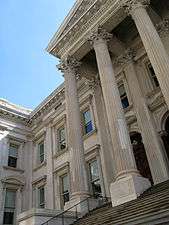 Kellum's front facade
Kellum's front facade Second floor court chambers before restoration
Second floor court chambers before restoration Tweed Courthouse staircase
Tweed Courthouse staircase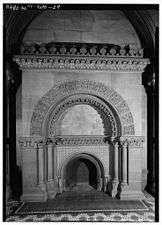 Eidlitz's 3rd-floor chamber, fireplace detail
Eidlitz's 3rd-floor chamber, fireplace detail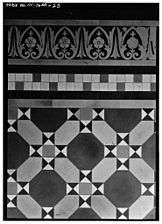 Mosaic floor pattern
Mosaic floor pattern 2nd-floor of Eidlitz's glazed courtyard
2nd-floor of Eidlitz's glazed courtyard
See also
References
- Notes
- ↑ Official Site
- 1 2 National Park Service (2010-07-09). "National Register Information System". National Register of Historic Places. National Park Service.
- 1 2 "Old New York County Courthouse". National Historic Landmark summary listing. National Park Service. 2007-09-19.
- ↑ Little was a political appointee on the New York City Board of Supervisors who shared ex officio credit.
- 1 2 3 Landmarks Preservation Commission, 16 October 1984
- ↑ ""Old New York County Courthouse", December 1975, by Cathy A. Alexander and Ralph Christian (National Register of Historic Places Inventory-Nomination)" (pdf). National Park Service. 1975-12. Check date values in:
|date=(help) - ↑ "Old New York County Courthouse--Accompanying 3 photos, exterior, from 1967 and 1974. (National Register of Historic Places Inventory-Nomination)" (pdf). National Park Service. 1975-12. Check date values in:
|date=(help) - ↑ New York City Landmarks Preservation Commission; Dolkart, Andrew S. (text); Postal, Matthew A. (text) (2009), Postal, Matthew A., ed., Guide to New York City Landmarks (4th ed.), New York: John Wiley & Sons, ISBN 978-0-470-28963-1, pp.28-29
- ↑ Waite, John G.; Rankin, Nancy A. (2004). "Tweed Courthouse: New Approach to Life-Safety Management in a Landmark Public Building". APT Bulletin. 35 (1). JSTOR 1504835.
- ↑ White, Norval & Willensky, Elliot (2000), AIA Guide to New York City (4th ed.), New York: Three Rivers Press, ISBN 978-0-8129-3107-5
- ↑ Guide to NYC Landmarks as cited at NYC Citywide Administrative Services web site, accessed August 1, 2011
- ↑ Public Tours: Tweed Courthouse
External links
| Wikimedia Commons has media related to Tweed Courthouse. |
- Official Page
- Landmark Tweed Courthouse Has a Checkered History Lower Manhattan info website
- A Brief History of the Tweed Courthouse NYC.gov
- The House that Tweed Built Archaeology magazine
- Landmarks Preservation Commission, The Tweed Courthouse Historic Structure Report, 1980
